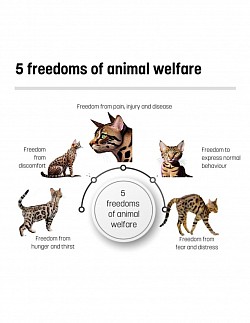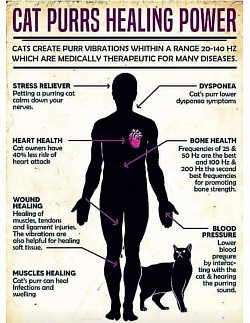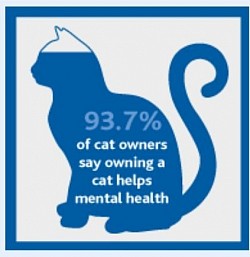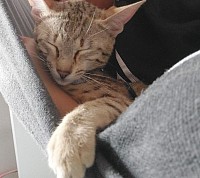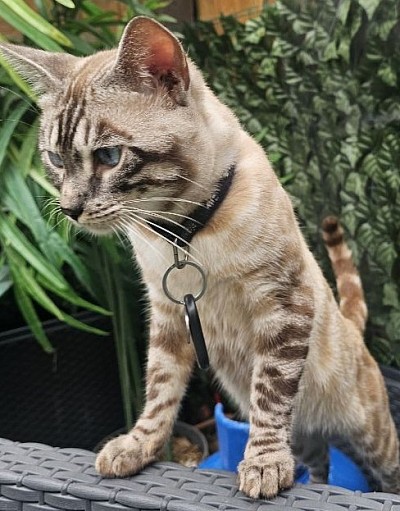Miscellaneous
Miscellaneous
Miscellaneous
How cats can help you calm down
How cats can help you calm down
Reduce stress hormones: Studies show that interacting with cats, including petting them, can lower levels of cortisol, often referred to as the stress hormone.
Increase feel-good hormones: Spending time with cats can also trigger the release of hormones like serotonin, dopamine, and oxytocin, which are associated with positive feelings, bonding, and stress relief.
Provide companionship and combat loneliness: Cats offer companionship and a chance to build a relationship with another being, which can be particularly beneficial for individuals who live alone and may experience anxiety or loneliness.
Offer sensory comfort: The warmth of a cat's body, the soft fur, and the rhythmic purr can be soothing and provide sensory input that can help you relax and stay present in the moment when feeling distressed.
Reduce anxiety: In addition to elevating mood, interacting with cats can promote calmness and decrease feelings of isolation.
Promote mindfulness and relaxation: Cats tend to live in the moment. Observing their peaceful and playful nature can help bring you into a state of mindfulness and encourage you to slow down and appreciate simple moments of relaxation.
Can be used in therapy settings: Cats are sometimes involved in therapy and wellness activities for people dealing with various health issues or mental disorders
Cats: The Definitive Guide to Feline Companionship
Cats: The Definitive Guide to Feline Companionship
Cats have been cherished companions to humans for millennia, offering affection, companionship, and joy.
This comprehensive guide explores the captivating realm of feline companionship, examining the evolutionary history of cats, their physiology, sociocultural significance, the economics of cat ownership, and critical considerations regarding cat welfare and ethics. Join us as we uncover the mysteries surrounding our beloved feline friends.
The Evolutionary Journey
The evolutionary history of cats is a compelling narrative spanning thousands of years. These enigmatic animals are believed to have descended from wild ancestors such as the African wildcat. This ancient lineage has profoundly influenced their behaviour and physiology, setting the stage for their domestication.
As descendants of wild progenitors, cats retain a distinctive set of instincts and traits refined over generations. Their acute senses, agile physiques, and retractable claws are evolutionary adaptations that enable them to thrive in natural environments. These attributes not only facilitated their survival but also contributed to their prowess as hunters.
Over time, humans recognised the value of cats as companions and protectors. Their innate hunting abilities proved invaluable in controlling rodent populations that threatened crops and stored food supplies. Consequently, cats gradually transitioned from wild creatures to domesticated partners.
Breed Genesis and Differentiation
Domestication paved the way for the development of diverse cat breeds. Through selective breeding, humans accentuated specific traits, resulting in distinct breeds characterised by unique appearances and temperaments.
From the sociable and playful Siamese to the dignified and aloof Persian, each breed offers a variety of companionship options. The Siamese, noted for its striking blue eyes and sleek coat, is renowned for its outgoing and vocal nature. Conversely, the Persian, with its luxurious long fur and serene demeanour, embodies elegance and tranquillity.
These breed distinctions extend beyond aesthetics. Each breed exhibits particular traits selectively bred over generations. Some breeds are predisposed to specific health concerns, while others are recognised for intelligence or athleticism. Understanding these breed-specific characteristics is essential to providing optimal care and environments for our feline companions.
As the human-cat bond evolves, so does our appreciation of their rich evolutionary heritage. Exploring their wild origins and domestication enhances our understanding of the diverse and captivating world of cats, deepening their appeal as companions.
The Physiology of Feline Behaviour
The physiology underlying feline behaviour encompasses intricate neural pathways and hormonal influences that govern a cat’s instincts and natural tendencies. Comprehending these physiological factors provides valuable insights into the behaviours exhibited by cats.
Neural Pathways and Instincts
Cats possess a sophisticated network of neural pathways regulating behaviours such as hunting, grooming, territoriality, and social interaction. These pathways develop through a combination of genetic predisposition and early life experiences. Understanding these neural mechanisms is crucial for interpreting cat body language, a vital component in discerning their emotional states and intentions.
Regarding hunting, cats demonstrate exceptional skill and precision. Their neural circuitry is finely attuned to detect and track prey, enabling them to pounce with remarkable accuracy. These instincts are deeply embedded in their genetic makeup and have been refined through millennia of evolution.
Grooming behaviour is similarly governed by neural pathways. Cats are meticulous groomers, dedicating significant time daily to maintaining their coats. This behaviour not only preserves coat condition but also serves as a form of self-soothing and stress alleviation.
Territorial behaviours are also influenced by neural pathways. Cats instinctively mark their territory via urine spraying or scratching, communicating their presence to other felines. Understanding the reasons behind why cats spray offers insight into their territorial instincts and communication methods.
Social behaviours in cats are likewise regulated by neural mechanisms. Although often perceived as solitary, cats maintain social hierarchies within colonies. Behaviours such as mutual grooming and play are essential for reinforcing social bonds and minimising conflict.
Hormones and Behavioural Outcomes
Hormones significantly influence feline behaviour, particularly reproductive hormones that impact instincts and mood. Fluctuations in hormonal levels manifest in behavioural changes, underscoring the importance of understanding cat language to interpret these variations accurately.
During mating seasons, male cats experience elevated testosterone levels, often resulting in increased aggression, territoriality, vocalisation, urine spraying, and a heightened drive to roam in search of mates.
Female cats undergo hormonal shifts during their heat cycles, which may lead to increased affection, vocalisation, and mating behaviour.
Recognising hormonal influences is vital for creating environments that support cats’ physical and emotional well-being. Providing appropriate outlets for natural instincts—such as scratching posts and opportunities for play and exercise—helps accommodate these behavioural changes.
Hormonal fluctuations also affect overall mood and temperament, potentially causing variations from aggression to anxiety. Awareness of these changes enables better management of behavioural challenges.
In summary, the physiology of feline behaviour encompasses complex neural and hormonal factors. Understanding these elements allows us to better support our feline companions by catering to their innate instincts and promoting their holistic well-being.
Sociocultural Impact
Cats have been intricately woven into human culture for centuries, celebrated through ancient art, mythology, modern literature, and digital phenomena. From their exalted status in ancient Egypt to their prominence in today’s digital age via a proliferation of cat memes, cats have consistently demonstrated their cultural significance. Their enduring symbolism of beauty, mystery, and independence is evident in historical depictions, myths, contemporary art, literature, and their ubiquitous presence online. This fusion of tradition and modernity highlights the timeless and multifaceted influence of cats in human society.
In ancient Egyptian art, cats were frequently portrayed alongside deities, symbolising their divine association. Egyptians believed cats possessed magical qualities and served as protectors against malevolent spirits, leading to widespread veneration and inclusion in religious rituals.
During the Middle Ages, cats were often linked to witchcraft and persecuted alongside alleged practitioners of magic. This negative perception persisted for centuries, casting cats as mysterious and elusive figures in literature and art.
However, the 18th and 19th centuries witnessed a resurgence in feline popularity. Romantic-era artists and writers were captivated by cats’ enigmatic nature, incorporating them into works as symbols of independence, sensuality, and untamed spirit. Paintings, poetry, and novels from this period frequently featured cats in these roles.
Cats and Internet Culture
In recent decades, cats have become internet sensations. Memes, videos, and photographs have propelled cats to digital stardom, fostering a phenomenon known as “cat culture.” This surge in cat-themed content has entertained millions and united enthusiasts worldwide in their shared affection for these captivating animals.
Platforms like YouTube have popularised cat videos, offering viewers amusement and stress relief. Whether showcasing a cat playing with yarn or engaging in humorous antics, these videos provide widespread entertainment. The internet has also created communities where cat lovers connect, share experiences, and foster a sense of belonging.
The rise of internet celebrity cats such as Grumpy Cat and Lil Bub, who have amassed millions of followers and appeared in commercials and films, exemplifies this trend. These feline celebrities have brought joy to countless individuals and symbolise resilience and overcoming adversity.
Moreover, the internet has facilitated the dissemination of knowledge regarding cat care, behaviour, and health. Online forums and communities offer platforms for cat owners to exchange advice, seek support, and learn from experts. This digital revolution has transformed human-cat interactions, creating a global network of passionate feline advocates.
The Economics of Cat Ownership
Market Size and Trends
The pet industry is a flourishing sector, with cats representing a substantial segment. Cat ownership has steadily increased as more individuals recognise the benefits of feline companionship.
As the population of cat owners grows, so does the demand for cat-related products and services. This has fostered a robust industry catering to owners’ needs, encompassing cat food, toys, grooming services, and veterinary care. The economic impact of cat ownership is significant.
A primary driver of market growth is heightened awareness of cats’ positive effects on human well-being. Research indicates that owning a cat can reduce stress, lower blood pressure, and enhance mental health. This awareness fuels the increasing demand for feline companions.
Additionally, social media has amplified the popularity of cat ownership. The abundance of charming and humorous cat content on digital platforms generates joy and entertainment, influencing many to welcome cats into their homes.
Spending Psychology of Cat Owners
Cat owners are dedicated to investing in their pets’ well-being and happiness. Their spending habits reflect this commitment, prioritizing premium food, comfortable bedding, and engaging toys.
Regarding nutrition, owners recognize the importance of a balanced, high-quality diet for their cats’ health. They often opt for premium brands offering superior ingredients and specialized formulas to meet their pets’ dietary needs.
Beyond nutrition, owners invest in creating enriching living environments. This includes purchasing cozy beds, scratching posts, and climbing structures that provide physical and mental stimulation. Such investments enhance feline welfare and contribute to harmonious cohabitation.
Play and mental engagement are also prioritized. Owners frequently acquire a variety of toys—interactive puzzles, feather wands, laser pointers—that cater to cats’ natural instincts, promoting exercise and cognitive enrichment.
Importantly, cat owners’ dedication extends beyond material goods. They invest time and effort in nurturing strong bonds through grooming, training, and interactive play, recognizing that the emotional connection transcends monetary value.
Cat Welfare and Ethics
Ensuring cat welfare is paramount for every owner. As cherished companions, cats deserve humane treatment that fosters their happiness and health.
A critical component of welfare is providing a safe, stimulating environment. Cats’ natural curiosity and activity levels necessitate spaces that encourage exploration, play, and exercise. Supplying scratching posts, interactive toys, and designated climbing or perching areas supports their innate behaviors and prevents boredom, promoting mental and physical well-being.
Regular veterinary care is essential for maintaining health. Like humans, cats can develop health issues that may go unnoticed without professional assessment. Routine check-ups enable early detection of problems, administration of vaccinations, and preventive treatments, ensuring longevity and quality of life.
Proper nutrition is equally vital. Cats require diets rich in high-quality protein and essential nutrients distinct from other species. Consulting veterinarians to tailor diets to individual needs supports optimal health and well-being.
Controversial Practices and Debates
Several practices and debates within cat welfare continue to provoke discussion, fostering awareness and advancement in care standards.
One notable issue is cat spraying. Often misunderstood and stigmatized, spraying is a natural communication and territorial marking behavior. Comprehending its causes and managing it humanely is crucial. Responsible ownership involves addressing spraying without resorting to extreme measures such as declawing or abandonment. Educating ourselves on why cats spray promotes compassion and understanding.
Declawing remains a contentious practice. While some advocate it to prevent property damage or injury, many oppose it due to the pain and long-term physical and psychological harm it inflicts. Declawing entails amputating the last bone of each toe, which can have severe consequences. Alternatives such as providing appropriate scratching surfaces and regular nail trimming should be prioritized.
The debate over indoor versus outdoor living for cats also persists. Indoor advocates emphasize protection from hazards like traffic, predators, and disease. Conversely, proponents of outdoor access highlight the importance of natural behaviors and environmental enrichment. Striking a balance—through supervised outdoor time or enclosed spaces—can offer safety alongside stimulation.
Ethical considerations in breeding are equally significant. Responsible breeding supports breed preservation and health, whereas unethical practices contribute to health problems and overpopulation. Supporting reputable breeders and considering adoption are vital steps toward ethical cat ownership.
Engaging in informed dialogue and staying educated on these topics empowers owners and enthusiasts to make decisions that prioritize feline welfare and happiness.
Conclusion
Cats possess a rich history intertwined with humanity, evolving from wild ancestors into treasured domestic companions. By understanding their evolutionary background, physiology, sociocultural impact, economic significance, and welfare considerations, we can provide exemplary care for our feline friends. Whether curled on our laps or exploring their surroundings with curiosity, cats continue to captivate our hearts and enrich our lives with their unique companionship.

